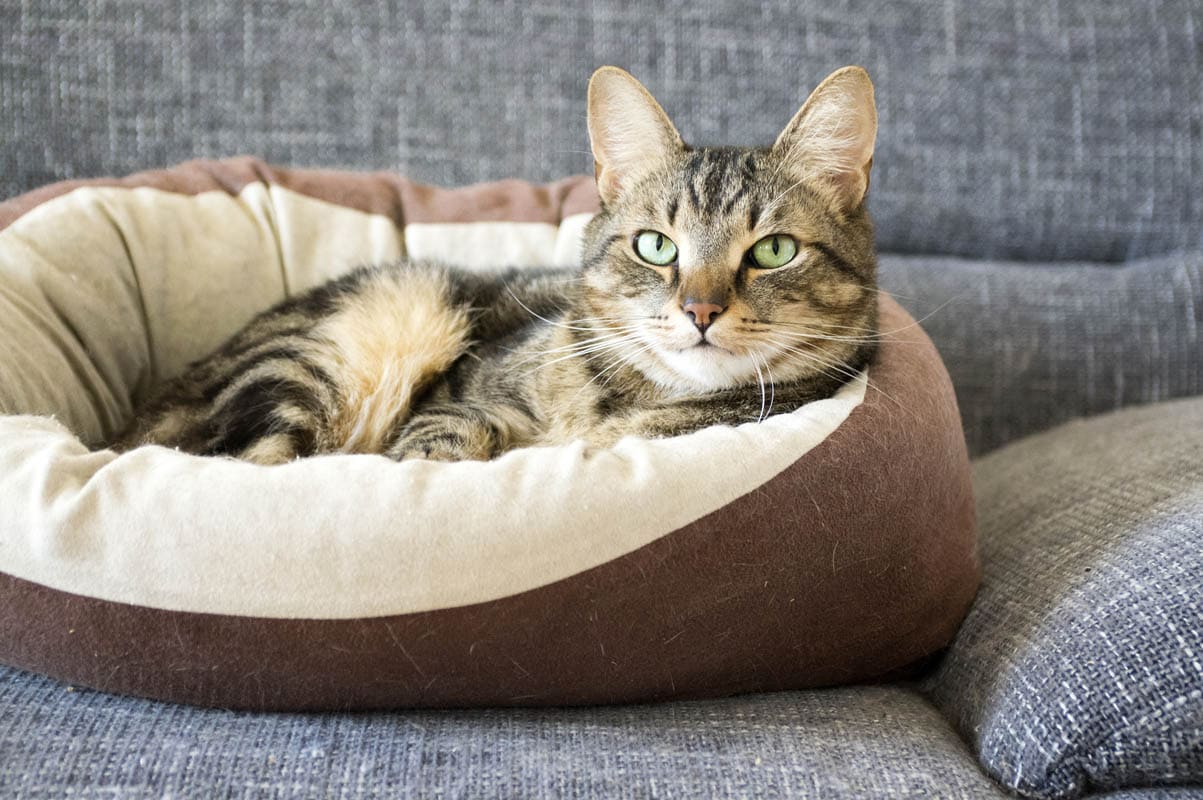Cat beds come in a vast array of colours, shapes, sizes and styles. You are only limited by budget and taste. Cats spend around 15 hours a day sleeping, so a cat bed is going to be a well-used purchase.
Types of cat beds
- Wicker baskets. These traditional style baskets are cheap, but can be difficult to wash and can be easily chewed by your cat.
- Plastic baskets. Similar in shape to the wicker baskets and should be lined with soft blankets or cushions. Advantages of plastic beds are that they can be disinfected in the event of a disease/parasite outbreak (such as ringworm).
- Doughnut cat beds (see below): Made of soft material and stuffed with a soft lining these beds have slightly higher sides.
- Cat hammocks/radiator beds. These beds are usually made of wool and hung over radiators. Advantages are that they also provide a perch for your cat to watch the world go by, disadvantages are that kittens or older cats may find it difficult to jump up to.
- Enclosed/cat igloo beds. Usually made from fabric, with a stuffed lining these beds offer security, warmth and privacy to your cat.
What to look for in a cat bed
There are many factors you should look at when buying a cat bed. These include:
- Size. It should be large enough for your cat to stand and turn around in but should be snug enough to make your cat feel secure.
- Warmth. It should have high enough sides to keep your cat warm. Enclosed beds hold the heat in better, if it is an open bed, it can be placed close to a heater, but not close enough to be a fire hazard or burn your cat.
- Ability to wash/clean. If you decide on a fabric cat bed, look for one that is machine washable. This is important as your cat bed will need to be cleaned frequently to remove dirt, fur and in the event of a disease/parasite outbreak.
- Comfort. This goes without saying. Either opt for a bed that has an adequate filling or if choosing a plastic style bed, line it with soft blankets.
- Look at where your cat sleeps now? Does he have a preference for open beds or does he seek out enclosed places? We have one cat who loves caves, so an enclosed bed is perfect for him.
- Factor in the cat’s age and health status. An old arthritic cat or a young kitten will not be able to climb into a bed with high sides. A senior cat may also benefit from a bed that has a heating pad in the cooler months.
Where to buy a cat bed
Pet shops, eBay and online stores are the best places to buy a bed?
Where should the cat bed be placed?
Beds should be placed out of high traffic areas but still within view of family members. So in a quiet part of the lounge room, preferably by a window.
I have more than one cat, how many cat beds should I buy?
There should be one bed per cat, although especially close cats may prefer to sleep together.
Encouraging your cat to use its bed
It is always best to encourage cat bed use when the cat is still a kitten. Start by placing some treats, toys or catnip in the bed. If the cat goes in, heap praise on it.
Cat beds for sick cats
Sometimes your cat’s bed will have to double up as a hospital. Again, it is important to be able to clean the bed, especially if the cat is suffering from a contagious disease.
Sick or elderly cats may also appreciate a heating pad if the bed cannot be placed close to a heater. The heating pad should be set to low, and there should be enough space for your cat to move off the pad if it becomes too hot. Electric heating pads should be avoided.

